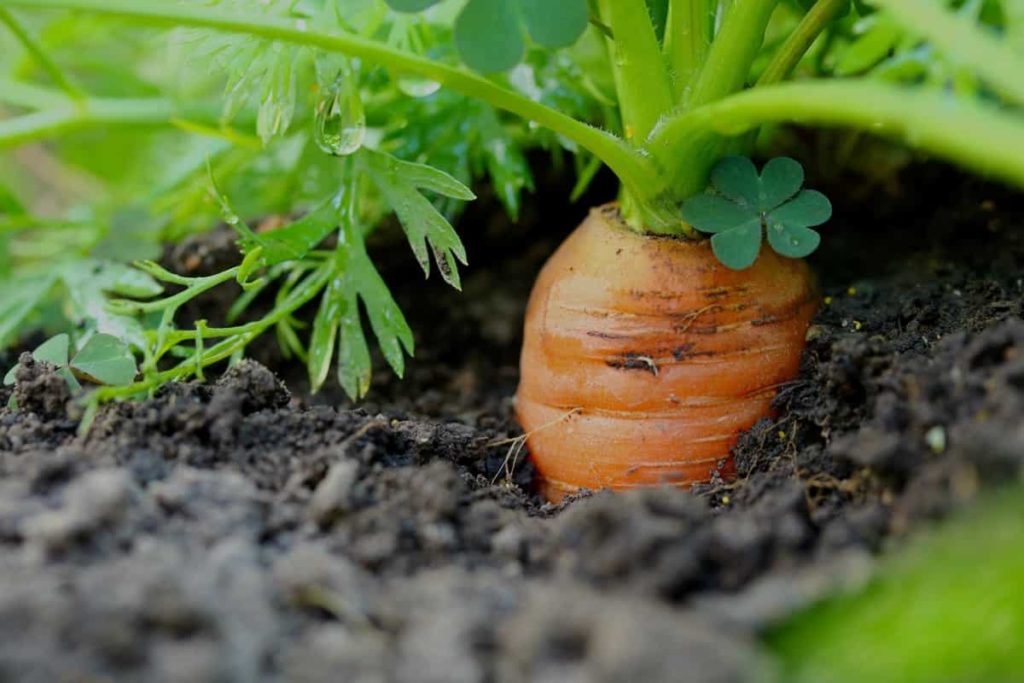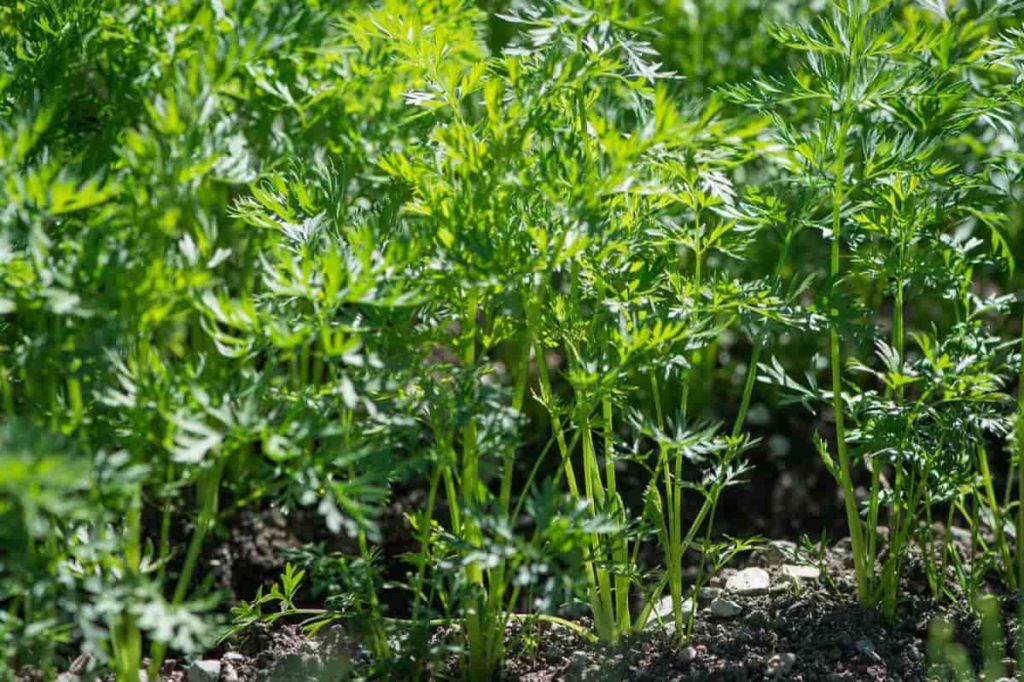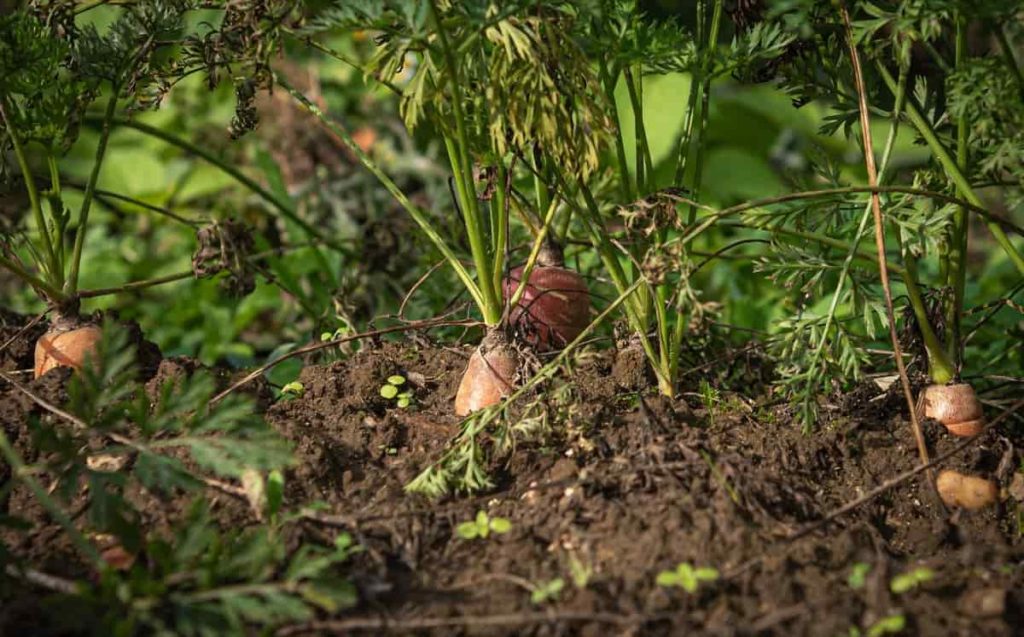Carrot plants are one of the most common crops globally, and they are sweet and juicy. They are as fresh as they are beautiful. That is why gardeners grow different varieties of Carrots. There are purple Carrots, white Carrots, orange, red, creamy, and all shades. Many home gardeners have done an easy job of growing their nutritious and aesthetically pleasing Carrots. Let’s check out 18 common Carrot plant problems below.

Many problems we are facing when growing Carrots are stopping growth, root rot, and Carrots that are not bright orange. Since Carrot roots grow below the surface, anything can go wrong. Roots get distorted, extra hairy, and crack. To solve poor growth, frostbites, and leggy-ness, you must change the growing conditions for your Carrots, that is, the amount of sunlight and water they get. For problems like pests and diseases, you may have to use pesticides or fungicides.
18 common Carrot plant problems
Carrots are not developing
The seedlings freeze only in time and space after sowing seeds and first emerging true leaves. It produces no root that penetrates the soil and becomes thick underground. Leaves grow naturally, but no root takes practical shape.
- Temperature – Although Carrot seeds require temperatures between 13 to 23°C to grow, if the soil temperature goes above 23°C, it will not create roots.
- Soil – Heavy soil is a natural barrier to roots. Carrot struggles to develop in the rocky soil.
- Spacing – Carrots need space to grow. By nature, they are not competitive, and sensitive roots will stop developing if the plants are too dense in patches or if they have to compete with weeds.
- Drought – Regular water and moist soil are essential to healthy Carrot roots. Dry soil makes it difficult for the root to grow and reach its length and circumference.
Solution – Plant Carrot seeds as quickly as possible in early spring. This way, you will give the cool weather vegetables plenty of time to grow and prepare roots before the weather gets too hot. Modify the soil to make it sandier and looser. If the soil is clay, you can also plant Carrots in the raised beds. Thin the seedlings leaving 2 to 4 inches of space between them after the first two sets of true leaves emerge. Remove weeds and debris regularly and keep beds clean to avoid competition.
Carrot damping off
While the germination rate of Carrot seeds is exceptionally high, it is no guarantee that your Carrot patch will be a fantastic success. You have a common problem when the seedling dies for no apparent reason. If you can’t see a reason for the sudden demise of Carrot seedlings, that doesn’t mean the pathogens are not hidden in the soil. As the fungus attacks the roots and trunks of the seedlings, the plant shows signs of stress. First, the leaves are brown and wilt. Then the stem becomes mushy and breaks under the weight of the leaves. The plant eventually dies.
In case you missed it: Carrot Planting Frequently Asked Questions (FAQs)

Solution – Treat the infected seedlings and prevent the spread of the disease in the rest of the patch. If you notice signs of Carrot moistening, stop the water and let the soil dry. It will limit the spread and activity of the bacteria. Use fungicides with copper ingredients as they are effective against this fungus. Finally, rotate Carrots in the soil once every four years to eliminate the pathogens.
Carrots are rotting
The real culprit behind rotting Carrot plants is the root rot disease. Unfortunately, for root rot in Carrots, you lose an essential part of the plant when there is root rot.
Solution – The soil’s improper condition causes root rot in Carrot plants. It is essential to ensure that your garden has proper drainage when preparing the garden. Proper drainage means that water does not accumulate in this area and that it seems deep into the ground.
To ensure healthy soil, avoid keeping your garden under a hill or near a swamp. When water sits in an area, it is prone to accumulating fungi seeds and growing diseases. Although Carrots need moderate amounts of water to grow properly, they should not be left to grow in standing water either.
Carrots cracking
The two main reasons for the cracking of Carrots in the soil are inadequate water and fertilizer. Fortunately, this serious problem is easy to fix.
In case you missed it: Carrot Growing Tips, Ideas, Secrets, and Techniques

Solution – Like all the growing Carrot problems that relate to the surroundings of Carrots, you will need to focus on soil, temperature, and water. Fertilizers can be a contributing factor in case of a Carrot burst. Water Carrots regularly. Do not let the top one inch of soil dry. Sprinkle shallows to moisten the soil without overwatering the plants while watering. Before sowing the seeds, check the soil and check the nitrogen level in the garden.
If nitrogen is too high, it can cause roots to burst and become hairy. Do not plant Carrots in a place where beans grow first. Beans fix nitrogen in the soil. Remove rocks and debris from the soil as they can injure roots and cause them to separate.
Leggy Carrot plants
Leggy plants may look healthy, but they have been deprived of the resources that plants need to nurture and thrive. One of the main reasons Carrot plants are leggy is that they have suffered from inappropriate amounts of sunlight. When you design your garden, make sure the Carrots have enough sunlight. Carrot plants will not grow properly without moderate amounts of light.
Solution – If you determine that lack of sunlight is causing the leggy plants, rearrange your garden to accommodate them. Another reason your Carrot plants can be leggy is poor water. It is essential to ensure that you water your garden regularly as Carrot plants are fluffier and thinner when healthy, so it is easy for them to dry and long to grow long. Carrots should be watered evenly on the base of the plant and kept relatively moist. Do not let them dry.
Deformed Carrots
Solution – Poor soil, heavy soil, nematodes, and phytoplasma aster are some reasons for deformed Carrots. Solarize the soil to eliminate the bacteria that cause phytoplasma aster. Turn the top 12 inches of soil and let it rest under the sun for a few days. Remove plants that produce extra hairy roots and dispose of them to prevent germ spread. Mix a lot of organic material with soil before planting seeds to limit the spread of pathogens. Clean the garden of debris and plant residue saplings that can shelter pathogens.
In case you missed it: Growing Carrots In Balcony – In Pots, Planting Guide

Pests
Aphids
Aphids are common pests on Carrot plants. They like to eat young Carrot greens, making the leaves yellow and wilt. It spoils the roots. The Aphids only cause large numbers of significant problems.
Solution – Leaving natural enemies in the gardens, such as ladybugs and lacewings larvae, helps keep the aphid population under control. You can also use neem oil sprays to control the aphids.
Carrot root fly
Carrot root flies attack Carrots and other root crops, which feed directly on the root system. Once you find the Carrot root flies, you must immediately harvest all your Carrots as the pests spread rapidly, destroying all the roots.
Solution – The insect attacks Carrots, Parsnips, celeriac, and other Carrot family plants. Rotating crops is a good idea to avoid Carrot root flies in your soil. You can also plant fellow plants like Onions to discourage these pests.
Carrot rust fly
Carrot rust flies eat small roots of Carrot plants and eat tunnels through edible roots. The larvae produce a strange rust-colored material inside the tunnels. Carrot rust flies cause plants to make yellow with stunt growth. It is difficult to identify this problem first, as green tops look healthy until the plant dies.
Solution – When you remove Carrots, you will find insects inside your Carrots. The most effective treatment for Carrot rust fly is Neem oil.
Carrot weevil
Adult Carrot weevils are dark brown-colored beetles about six millimeters long. They live in winter, colder in plant debris. If weevils affected your Carrot plants last year, these pests are likely in the soil, waiting for the next sowing of Carrots. Carrot weevils eat leaves and make holes in the greens, but the damage above the ground is rare to be severe.
Solution – If you discover them in your roots for a year, the best way to avoid them is to leave predatory nematodes to eat larvae in your garden. You can use pyrethrin spray based on the manufacturer’s instructions.
Celery worms
Celery worms hide on Carrot plants and Celery, Parsley, and Parsnip plants. These insects chew plant leaves and stem and eat all the green tops of Carrot plants.
Solution – The best way to get rid of celery worms is to handpick them. You can also try neem oil to get rid of these Carrot worms.
In case you missed it: Growing Organic Carrots in Backyard (Home Garden)

Leaf miners
Leaf mining pests lay eggs in the spongey layers between the upper and lower surfaces of the leaves. There are more than 200 species of leaf miners, and each species attacks different parts of plants. Not all Carrot plants are attacked, but those that usually focus on seedlings.
Solution – Remove the affected parts of the plants, and spray neem oil.
Nematodes
Nematodes live in soil and eat plant roots. Not all nematodes damage plants (some are beneficial), and thousands of nematode species exist. Root knots Bad species like nematodes cause knots on the roots, making it impossible for plants to bring out the nutrients needed in the rest of the plants. Solution – The nematode attack quickly causes your Carrots to die. Unfortunately, once Carrot plants are infected with nematodes, it is difficult to eliminate them from the soil.
Wireworms
One of the most common Carrot pests is wireworms. They are thin, yellow-brown, hard-bodied larvae from different beetles that like to infect Carrots, Celery, Lettuce, Turnip, and other plants. Wireworms puncture and tunnel through plant trunks, roots, and tubers.
Solution – Using homemade garlic spray to remove the wireworms, under a wooden board in your garden, you can collect these pests and remove the board, after which they can then be destroyed in the fire.
Diseases
Black rot
It is a common fungal Carrot disease that causes the salinity of seedlings, scorched leaves, black rings on leaves, and lesions on the roots. It spreads rapidly in gardens and remains in the soil for eight years.
Solution – It is difficult to control black rot once it is in your garden. It is important to practice crop rotation, and you need to treat seeds with hot water before planting. Plant resistant varieties to help reduce your plant black rot risk.
Cavity spot
Symptoms include gray lesions in the roots of Carrot plants. Then the outer layer bursts and small vertical cracks begin to form.
Solution – It is a fungus that lasts for years in the soil. The best way to overcome this is with cultural methods and rotating crops. Applications of fungicides are also the best idea.
In case you missed it: Growing Hydroponic Carrots – A Full Guide

Alternaria blight
The spots appear on the margins of the first leaflets and are dark brown to black and irregular in shape. As the disease progresses, whole leaflets can die, appearing to be scorched. The leaf spots of the Alternaria are generally found more on older leaves and plants than on young leaves. This is because the disease spreads rapidly on the old leaves of the maturing crop.
Control – If well-drained soil is selected and proper crop rotation is taken, it can control the disease. when fungus can survive in the seed, hot water treatment is recommended. Seed treatment with thiram before sowing is effective for controlling the disease. Crop circulation and destruction of infected plant material in the field will minimize disease infection, with copper oxychloride and fungicide applications preventing the disease.
Downy mildew
Downy mildew causes powdery growth on leaves, stalks, and bracts. In addition, the roots get distorted due to severe infection. While it doesn’t usually kill your plant, Downy mildew reduces your plant production, putting your plants at risk of other diseases or pests.
Solution – Prevention measures are most effective in preventing Downy mildew, but you can apply protective fungicides to defend your plants and prevent small infections. Sulfur applications also prevent early infections in the growing season.
- Where to Place Indoor Plants in Your Home
- How to Grow Tomatoes Organically at Home: A Comprehensive Guide
- Organic Gardening on a Budget: Low-Cost Methods and Materials
- Gongura Seed Germination and Planting Methods
- Cabbage Seed Germination and Selection
- Broccoli Seed Germination and Selection
- Asparagus Seed Germination and Variety Selection
- Seasonal Flower Gardening: Best Practices for Spring, Summer, Fall, and Winter
- How to Grow Hibiscus from Flower
- Plantation Ideas for Home Decoration: A Beginners Guide
- Flower Garden Designs and Layouts for Beginners
- Planting and Spacing Techniques in Papaya: A Beginner’s Guide
- Growing Gold: Essential Techniques for Planting Pineapples
- How to Make Kalanchoe Plant Bushy: Home Remedies and Solutions
- 11 Reasons Why Your Gardenia is Not Blooming: Home Remedies and Solutions
- Eco Elegance: The Guide to Designing a Drought-Tolerant Landscape
- Gardening on a Slope: Strategies for Hillside Landscaping
- Nourish and Flourish: Top Organic Mulches for Thriving House Plants
- Everything You Want to Know about Indian Mogra Flower: Discover Uses and Growing
- Green Thumb Success: Expert Tips for Cultivating Greenhouse Pumpkins All Year Round
- Maximize Growth & Flavor: The Ultimate Guide to Companion Planting in Herb Gardens
- How to Control Rhododendron Problems Naturally: Home Remedies and Organic Ways to Fix Them
- Natural Magic: The Remarkable Benefits of Cinnamon for Plants
- Best Steps to Revive Dying Tulip with Natural and Organic Treatment
- 10 Reasons Why Your Angel Trumpet is Not Blooming: Remedies and Treatment
- How to Fix Periwinkle Leaf and Flower-Related Problems: Natural Remedies and Solutions
- How to Fix Zinnias Leaf and Flower Problems: Discover Natural and Home Remedies
- Organic Steps to Induce Lemon Tree Flowers: A Comprehensive Guide
- Bloom Booster: Crafting the Perfect Homemade Bougainvillea Fertilizer
- Optimizing Growth: A Guide to Applying NPK Fertilizer for Potted Plants
- 10 Best Homemade Fertilizers for Rubber Plant: DIY Recipes and Application Method
- How to Boost Female Pumpkin Flowers: Effective Steps for More Flowers and High Yields
- Transform Your Indoor Garden: Top Benefits of Pink Salt for Houseplants
- 10 Best Homemade Fertilizers for Peacock Plants (Calathea): Easy DIY Guide
- Unlock Blooms: 9 Reasons Why Your Potted Chrysanthemum is Not Blooming
- 8 Reasons Why Your Potted Hibiscus is Not Blooming: Fix it with Simple Solutions